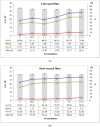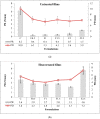Formulation and Characterization of Antimicrobial Edible Films Based on Whey Protein Isolate and Tarragon Essential Oil
- PMID: 32764387
- PMCID: PMC7464654
- DOI: 10.3390/polym12081748
Formulation and Characterization of Antimicrobial Edible Films Based on Whey Protein Isolate and Tarragon Essential Oil
Abstract
The effects of heat treatment and the addition of tarragon essential oil on physical and mechanical properties of films prepared with 5% whey protein isolate (WPI) and 5% glycerol were investigated in this study. Heat treatment of the film-forming solution caused increases in thickness, moisture content, swelling degree, water vapor permeability (WVP), b*-value, ΔE*-value, transmittance values in the 200-300-nm region, transparency, and puncture resistance of the film, but decreases in water solubility, L*-value, a*-value, transmittance values in the 350-800-nm region, and puncture deformation. When incorporated with tarragon essential oil, heat-treated films have the potential to be used as antimicrobial food packaging. The addition of tarragon essential oil in film-forming solution caused increases in moisture content, solubility in water, WVP, a*-value, b*-value, ΔE*-value, and transparency of the film; decreases in transmittance values in the range of 600-800 nm; and variations in swelling degree, L*-value, transmittance values in the range of 300-550 nm, puncture resistance, and puncture deformation. Nevertheless, different tendencies were noticed in UNT (untreated) and HT (heat-treated) films with regards to transparency, light transmittance, puncture resistance, and puncture deformation. Based on these findings, HT films show improved physical and mechanical properties and, therefore, are more suitable for food-packaging applications.
Keywords: antimicrobial properties; edible films; heat treatment; mechanical properties; physical properties; tarragon essential oil; whey protein isolate.
Conflict of interest statement
The authors declare no conflict of interest. The funders had no role in the design of the study; in the collection, analyses, or interpretation of data; in the writing of the manuscript, or in the decision to publish the results.
Figures










References
-
- Socaciu M.I., Semeniuc C.A., Vodnar D.C. Edible films and coatings for fresh fish packaging: Focus on quality changes and shelf-life extension. Coatings. 2018;8:366. doi: 10.3390/coatings8100366. - DOI
-
- Sothornvit R., Krochta J.M. Plasticizers in edible film and coatings. In: Han J.H., editor. Innovations in Food Packaging. 1st ed. Elsevier-Academic Press; Amsterdam, The Netherlands: 2005. pp. 403–433.
-
- Erginkaya Z., Kalkan S., Ünal E. Use of antimicrobial edible films and coatings as packaging materials for food safety. In: Malik A., Erginkaya Z., Ahmad S., Erten H., editors. Food Processing: Strategies for Quality Assessment. Springer; New York, USA: 2014. pp. 261–295.
-
- Morar M.I., Fetea F., Rotar A.M., Nagy M., Semeniuc C.A. Characterization of essential oils extracted from different aromatic plants by FTIR spectroscopy. Bulletin UASVM Food Science and Technology. 2017;74:37–38. doi: 10.15835/buasvmcn-fst:12634. - DOI
-
- Semeniuc C.A., Socaciu M.I., Socaci S.A., Mureşan V., Fogarasi M., Rotar A.M. Chemometric comparison and classification of some essential oils extracted from plants belonging to Apiaceae and Lamiaceae families based on their chemical composition and biological activities. Molecules. 2018;23:2261. doi: 10.3390/molecules23092261. - DOI - PMC - PubMed
Grants and funding
LinkOut - more resources
Full Text Sources
Molecular Biology Databases

